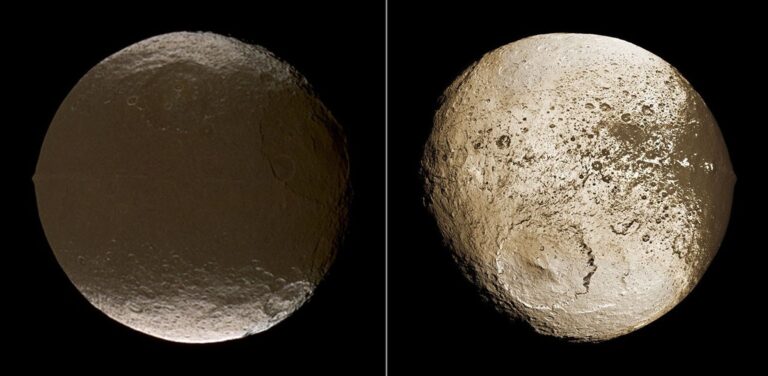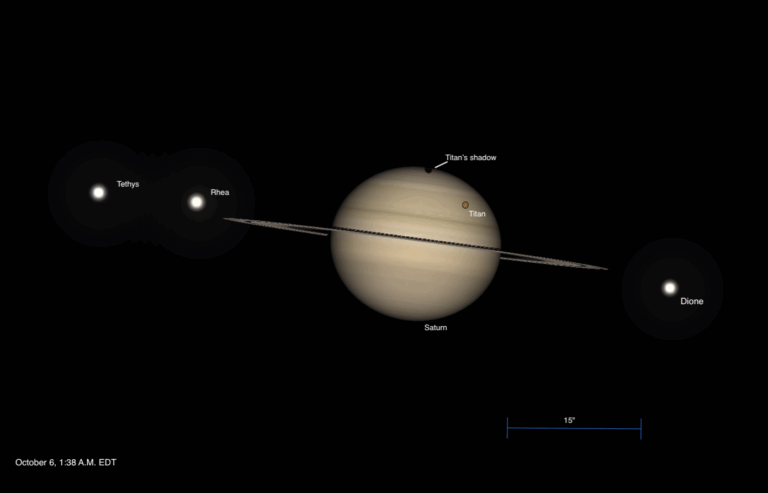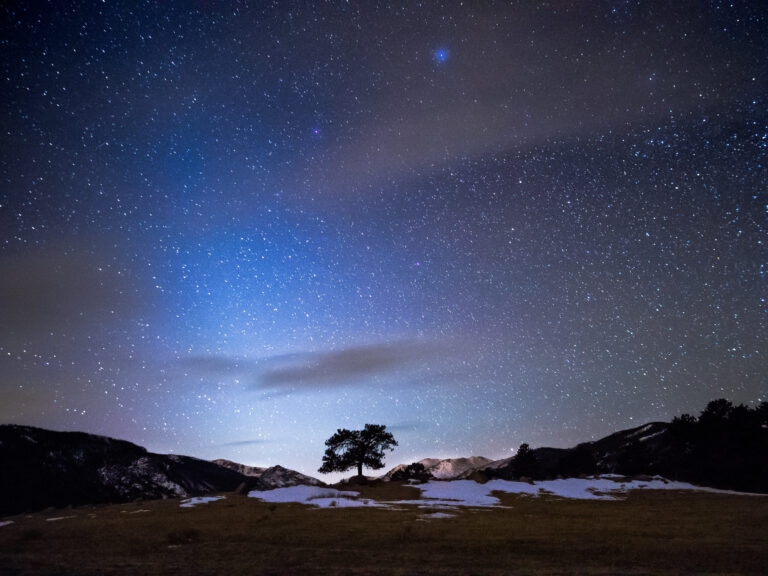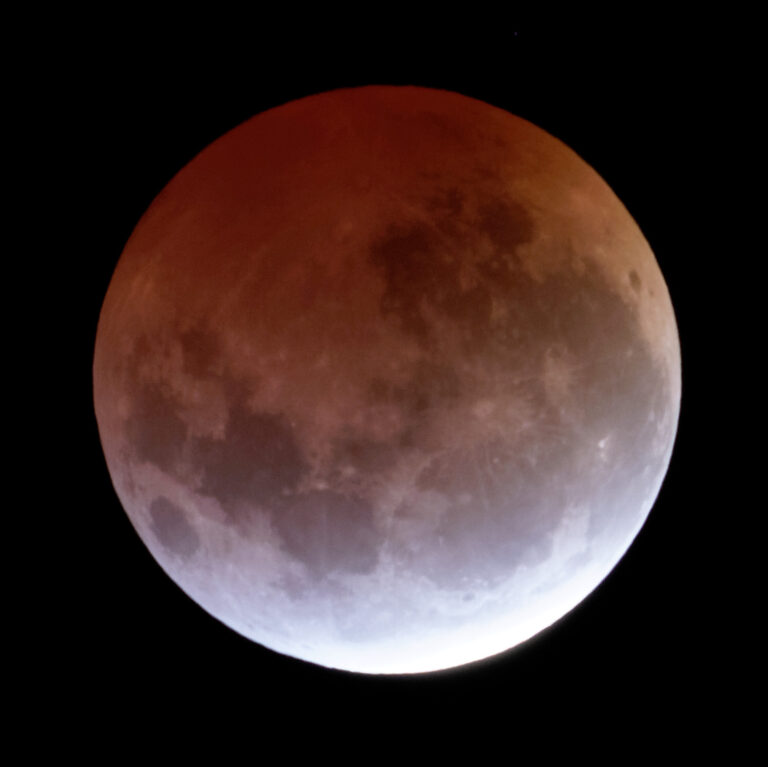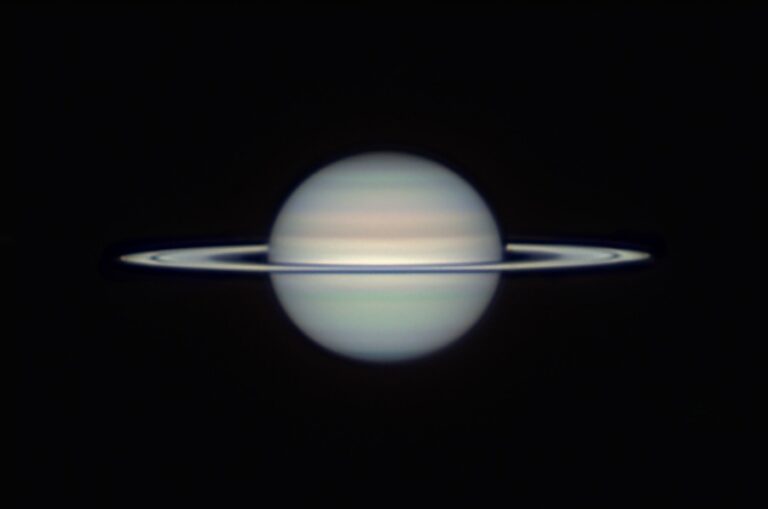
Key Takeaways:
- The article outlines a series of observational opportunities for planets, including Jupiter's Galilean moon shadow transits, close approaches of the Moon with Venus, Mercury, and Mars in the predawn or post-sunset sky, and a potential Titan transit across Saturn.
- Guidance is provided for observing prominent deep-sky objects such as the Summer Triangle asterism, the open clusters M29 and the Pleiades (M45), and the extended California Nebula (NGC 1499), emphasizing required optical aid and viewing conditions.
- Key transient celestial events featured include the peak of the Orionid meteor shower, detailing optimal viewing times and radiant location, and the closest approach of Comet C/2025 A6 (Lemmon), specifying its magnitude and position for observation.
- Specific targets for direct planetary observation are highlighted, such as the ice giant Uranus located near the Pleiades cluster, along with details for discerning planetary phases and disk sizes through optical instruments.

Sky This Week is brought to you in part by Celestron.
Friday, October 17
The Summer Triangle is now sinking in the west late in the evening as the winter constellations prepare to take over the sky. Look west around 10 P.M. local daylight time and you can still see the three bright stars of the Summer Triangle about 50° high.
Tonight the asterism appears almost as a right triangle, with a horizontal base formed by Altair in Aquila and Vega in Lyra. Above Lyra is Deneb in Cygnus, the third and final star in the large shape.
The plane of the Milky Way runs right through the Summer Triangle, sprinkling nebulae and star clusters throughout to be enjoyed. One of these is M29 in Cygnus, a small cluster that shines at 7th magnitude. You can find it just under 2° south of Gamma (γ) Cygni, also called Sadir. Containing about 50 to 80 stars, M29 spans about 7’ and is an excellent sight in binoculars or a small telescope. Low power is best to bring out its scattered stars.
Sunrise: 7:13 A.M.
Sunset: 6:17 P.M.
Moonrise: 3:22 A.M.
Moonset: 4:37 P.M.
Moon Phase: Waning crescent (11%)
*Times for sunrise, sunset, moonrise, and moonset are given in local time from 40° N 90° W. The Moon’s illumination is given at 10 P.M. local time from the same location.
Saturday, October 18
Jupiter stands high in the sky early this morning, ripe for viewing as two of its four Galilean moons chase their shadows across the cloud tops.
By 6 A.M. EDT, the gas giant stands nearly 60° high in the southeast, below (and outshining) the two bright stars marking the heads of Gemini the Twins. Zoom in on the planet with a telescope to see all four Galilean moons strung out to the planet’s east. Io is closest to the planet; next is Europa, then Callisto, with Ganymede farthest east.
Make sure you’re ready about half an hour later, as Io’s shadow is first to appear on the southeastern limb at 6:36 A.M. EDT. Europa’s shadow appears six minutes later. Io reaches the limb and starts to transit at 6:52 A.M. CDT, as twilight is starting to brighten skies across the Midwest. The western U.S. will be able to watch as Callisto’s shadow appears at the southeastern limb at 6:07 A.M. PDT (note the time change). Twelve minutes later, Europa begins its transit at 6:19 A.M. PDT, with Io finally beginning to approach the southwestern limb.
Sunrise: 7:14 A.M.
Sunset: 6:15 P.M.
Moonrise: 4:25 A.M.
Moonset: 4:58 P.M.
Moon Phase: Waning crescent (5%)
Sunday, October 19
The Moon and Venus hang close together in the predawn sky, sharing the sky in the constellation Virgo. An hour before sunrise, look east to spot Venus, the brightest point of light, blazing at magnitude –3.9 nearly 7° above the horizon and climbing. The delicate crescent Moon lies to its upper right, just 4° to the planet’s west.
Through a telescope, Venus appears 94 percent lit, its gibbous phase opposite the Moon’s thin crescent phase, with only some 4 percent of our satellite lit this morning. Venus’ disk stretches 11” on the sky, making its phase readily visible in the eyepiece.
Below them is the 3rd-magnitude star Porrima (Gamma Virginis), a famous double star with components about 4” apart, easy to split in a telescope. They are nearly identical blue-white suns that shine at roughly the same magnitude.
The Moon will pass 4° due south of Venus at 6 P.M. EDT this evening.
Sunrise: 7:15 A.M.
Sunset: 6:14 P.M.
Moonrise: 5:27 A.M.
Moonset: 5:18 P.M.
Moon Phase: Waning crescent (2%)
Monday, October 20
By 10 P.M. local daylight time, the Pleiades (M45) is already 30° high in the east. This lovely naked-eye cluster is well known across the world, sparkling in northwestern Taurus. Several of its stars are visible without optical aid — most observers can see five to seven individual stars in the shape of a tiny dipper (although don’t confuse this with the much larger Little Dipper in the north).
Through binoculars or a low-power telescope view (try your finder scope), many more stars begin to appear. The Pleiades stretches about 110’ on the sky — about the width of three and a half Full Moons — and contains some 500 stars, although only about 100 or so are visible under lower magnifications. This open cluster is roughly 100 million years old and is about 380 light-years from Earth.
Currently located south of the Pleiades is the ice giant Uranus. Glowing at magnitude 5.6, the planet is best seen in binoculars or a telescope. From magnitude 2.9 Alcyone (Eta [η] Tauri), simply drop 4.3° south-southeast to land on Uranus. Appearing as a “flat”, grayish star in your optics, the planet’s disk is some 4” wide.
Sunrise: 7:16 A.M.
Sunset: 6:12 P.M.
Moonrise: 6:27 A.M.
Moonset: 5:38 P.M.
Moon Phase: New
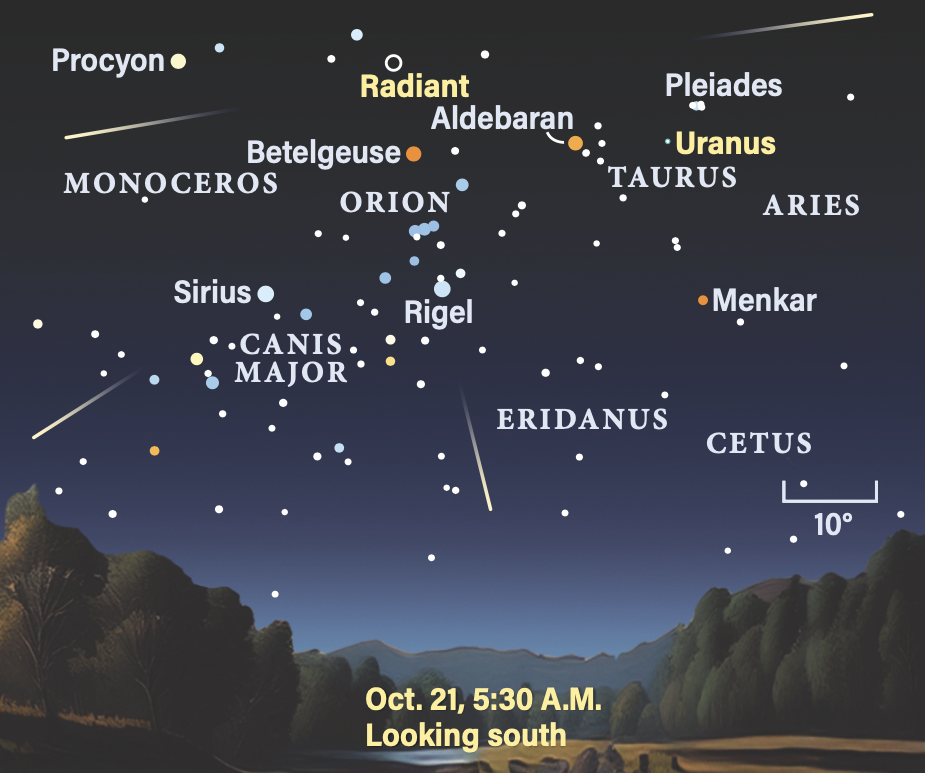
Tuesday, October 21
Today is a busy day! Mercury passes 2° south of Mars at 2 A.M. EDT — we’ll observe the pair in the evening sky, along with a Titan transit of Saturn.
But first, the Orionid meteor shower peaks as the Moon reaches New phase at 8:25 A.M. EDT. Additionally, Comet C/2025 A6 (Lemmon) passes closest to Earth today, skimming some 28.6 million miles (46 million kilometers) from our planet.
Let’s start with the Orionids, best viewed in the early-morning hours before sunrise. The shower’s radiant, the point from which its meteors appear to emanate, is highest in the sky around 5:30 A.M. local daylight time. Step outside and look south to locate the constellation Orion; the radiant is just above the Hunter’s red giant shoulder, Betelgeuse.
Now, scan the sky to either side of this point — meteors will have the longest trains about 40° away from the radiant. Some 20 meteors per hour are expected this morning, so it’s worth taking a look.

If you’ve also got a clear northeastern horizon, Comet Lemmon is some 4° high by 6 A.M. local daylight time. The comet is now 5th magnitude, readily visible through binoculars, a telescope, and in smartphone images. It’s roughly even in altitude with blazing Venus, visible in Virgo, but Lemmon lies in Boötes, nearly 40° northeast of the planet. This morning the comet is only 1.7° from magnitude 3.6 Rho (ρ) Boötis. Lemmon is rising but the sky will quickly start growing brighter as sunrise approaches.
You can also catch Comet Lemmon in the evening sky, when it is higher — an hour after sunset, it is still some 20° high in the west, now about 2.5° south of Rho Boo. Look for it to the upper right of bright Arcturus, Boötes’ magnitude –0.1 alpha star.
Earlier — half an hour after sunset — Mars and Mercury hang near the western horizon, about 4° high. The two planets are just over 2° apart, with brighter Mercury (magnitude –0.2) closer to the horizon, and Mars (magnitude 1.5) to its upper right. Use binoculars to orient yourself on Mercury, then skim north to find fainter Mars.
Finally, close out the evening with a transit of Titan across Saturn — possibly with its shadow. Although October 6 was billed as the last shadow transit of this series, there is a small chance a tiny portion of Titan’s shadow may be visible to some observers tonight. According to Astronomy contributing editor Martin Ratcliffe, the prediction appears to be near the limit of accuracy of planetarium programs, so while a slight graze of Titan’s shadow near Saturn’s north pole could be visible, it also may not happen.
Saturn is located in far northeastern Aquarius, near that constellation’s border with Pisces. At magnitude 0.7, it’s the brightest point of light in that region of the sky. Titan’s transit begins at 6:42 P.M. EDT, best seen from the Eastern and Central time zones. The moon is moving slowly, taking three hours to reach halfway across the disk. It finally approaches the northwestern limb shortly after midnight in the Eastern time zone (12:22 A.M. EDT on the 22nd), and is clear of the planet’s disk 20 minutes later.
If the shadow is visible, it will just graze Saturn’s north pole. Visibility will greatly depend on your location and local seeing conditions. As Titan is reaching end of its transit at 12:22 A.M. EDT (again, note the time: the 22nd in the Eastern time zone only), the shadow may appear as a small, semicircular divot at the pole. Take a look, and take some photos or video if you can — and let us know if you view a transit!
Sunrise: 7:17 A.M.
Sunset: 6:11 P.M.
Moonrise: 7:29 A.M.
Moonset: 6:01 P.M.
Moon Phase: Waxing crescent (1%)
Wednesday, October 22
With the sky clear of the nighttime Moon, try checking out the California Nebula (NGC 1499), located in southern Perseus. It reaches 45° in altitude by 11 P.M. local daylight time and is highest a few hours later, around 3 A.M.
You’ll find the California Nebula just 1° northeast of 4th-magnitude Xi (ξ) Persei — in fact, this star is the nebula’s light source, energizing the atoms of the cloud and making it glow. This huge nebula covers some 2.5° of sky along its long axis, and is 0.5° wide. Because it is so big, however, its overall surface brightness is very low; even though it glows at magnitude 6, you’ll need dark skies to capture it. Use a Hydrogen-alpha filter with your telescope to boost the nebula’s brightness against the background sky.
Although it is a bit difficult to observe visually, the California Nebula is a popular target for astrophotographers, so if you’ve got the setup, give capturing it a try.
Sunrise: 7:19 A.M.
Sunset: 6:10 P.M.
Moonrise: 8:31 A.M.
Moonset: 6:26 P.M.
Moon Phase: Waxing crescent (3%)
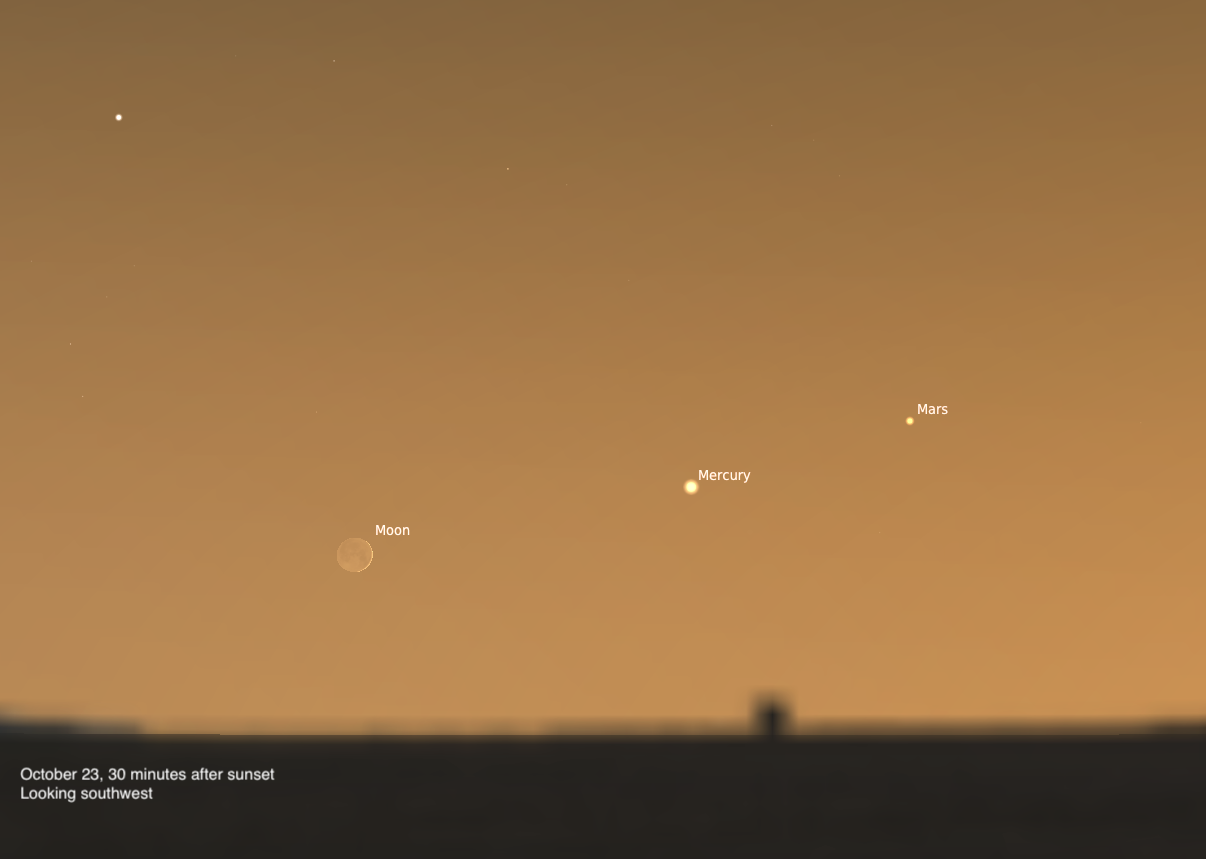
Thursday, October 23
The Moon passes 5° south of Mars at 9 A.M. EDT, then skims 2° south of Mercury at noon EDT. This evening, our satellite reaches apogee, the farthest point from Earth in its orbit, at 7:30 P.M. EDT. At that time, it will sit 252,553 miles (406,445 km) away.
If you’re quick and have a clear southwestern horizon, you can try catching the trio just after sunset. Half an hour after sunset, they are only 3° high in the southwest. The Moon is lowest, with brighter Mercury to its upper right, and fainter Mars to Mercury’s upper right.
At magnitude –0.2, Mercury should be one of the first points of light to appear in the deepening twilight. If you can’t see it by eye it should be easy to identify in binoculars, about 4.5° west of the Moon. Through a telescope, the small planet shows off a 73-percent-lit disk that is 6” wide.
Mars is magnitude 1.4 — much fainter and better observed with optical aid. You can locate it 3° west of Mercury, farther along the same line connecting Mercury and the Moon. Mars’ disk appears 4” wide and is virtually fully lit.
Sunrise: 7:20 A.M.
Sunset: 6:08 P.M.
Moonrise: 9:34 A.M.
Moonset: 6:57 P.M.
Moon Phase: Waxing crescent (6%)
Friday, October 24
The Moon passes 0.5° south of Antares at 9 P.M. EDT. However, the pair sets an hour and a half earlier; try catching them about 40 minutes after sunset, when they are low in the southwest.
At 6:50 P.M. CDT (in the Midwest), the delicate crescent Moon hangs almost directly below ruddy Antares, which marks the heart of Scorpius the Scorpion and shines at magnitude 1.1. The two are roughly 1.6° apart, easy to catch together in binoculars, which will likely show off a bit of earthshine on the Moon. This occurs when sunlight bounces off Earth and illuminates the portion of our satellite still experiencing night. Only the eastern edge of the Moon is directly illuminated, and you may be able to pick out the large, round shape of Mare Crisium.
To their upper left, see if you can spot the Teapot of Sagittarius as it begins to pop out against the darkening sky. This region is also low — about 15° high an hour after sunset — but you might be able to catch it before it sets.
Sunrise: 7:21 A.M.
Sunset: 6:07 P.M.
Moonrise: 10:35 A.M.
Moonset: 7:34 P.M.
Moon Phase: Waxing crescent (12%)


